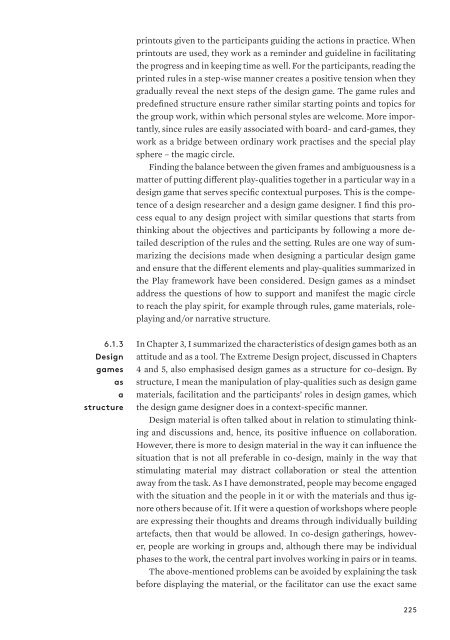Design games as a tool, a mindset and a structure Kirsikka Vaajakallio
Design games as a tool, a mindset and a structure Kirsikka Vaajakallio
Design games as a tool, a mindset and a structure Kirsikka Vaajakallio
You also want an ePaper? Increase the reach of your titles
YUMPU automatically turns print PDFs into web optimized ePapers that Google loves.
printouts given to the participants guiding the actions in practice. When<br />
printouts are used, they work <strong>as</strong> a reminder <strong>and</strong> guideline in facilitating<br />
the progress <strong>and</strong> in keeping time <strong>as</strong> well. For the participants, reading the<br />
printed rules in a step-wise manner creates a positive tension when they<br />
gradually reveal the next steps of the design game. The game rules <strong>and</strong><br />
predefined <strong>structure</strong> ensure rather similar starting points <strong>and</strong> topics for<br />
the group work, within which personal styles are welcome. More importantly,<br />
since rules are e<strong>as</strong>ily <strong>as</strong>sociated with board- <strong>and</strong> card-<strong>games</strong>, they<br />
work <strong>as</strong> a bridge between ordinary work practises <strong>and</strong> the special play<br />
sphere – the magic circle.<br />
Finding the balance between the given frames <strong>and</strong> ambiguousness is a<br />
matter of putting different play-qualities together in a particular way in a<br />
design game that serves specific contextual purposes. This is the competence<br />
of a design researcher <strong>and</strong> a design game designer. I find this process<br />
equal to any design project with similar questions that starts from<br />
thinking about the objectives <strong>and</strong> participants by following a more detailed<br />
description of the rules <strong>and</strong> the setting. Rules are one way of summarizing<br />
the decisions made when designing a particular design game<br />
<strong>and</strong> ensure that the different elements <strong>and</strong> play-qualities summarized in<br />
the Play framework have been considered. <strong>Design</strong> <strong>games</strong> <strong>as</strong> a <strong>mindset</strong><br />
address the questions of how to support <strong>and</strong> manifest the magic circle<br />
to reach the play spirit, for example through rules, game materials, roleplaying<br />
<strong>and</strong>/or narrative <strong>structure</strong>.<br />
6.1.3<br />
<strong>Design</strong><br />
<strong>games</strong><br />
<strong>as</strong><br />
a<br />
<strong>structure</strong><br />
In Chapter 3, I summarized the characteristics of design <strong>games</strong> both <strong>as</strong> an<br />
attitude <strong>and</strong> <strong>as</strong> a <strong>tool</strong>. The Extreme <strong>Design</strong> project, discussed in Chapters<br />
4 <strong>and</strong> 5, also emph<strong>as</strong>ised design <strong>games</strong> <strong>as</strong> a <strong>structure</strong> for co-design. By<br />
<strong>structure</strong>, I mean the manipulation of play-qualities such <strong>as</strong> design game<br />
materials, facilitation <strong>and</strong> the participants’ roles in design <strong>games</strong>, which<br />
the design game designer does in a context-specific manner.<br />
<strong>Design</strong> material is often talked about in relation to stimulating thinking<br />
<strong>and</strong> discussions <strong>and</strong>, hence, its positive influence on collaboration.<br />
However, there is more to design material in the way it can influence the<br />
situation that is not all preferable in co-design, mainly in the way that<br />
stimulating material may distract collaboration or steal the attention<br />
away from the t<strong>as</strong>k. As I have demonstrated, people may become engaged<br />
with the situation <strong>and</strong> the people in it or with the materials <strong>and</strong> thus ignore<br />
others because of it. If it were a question of workshops where people<br />
are expressing their thoughts <strong>and</strong> dreams through individually building<br />
artefacts, then that would be allowed. In co-design gatherings, however,<br />
people are working in groups <strong>and</strong>, although there may be individual<br />
ph<strong>as</strong>es to the work, the central part involves working in pairs or in teams.<br />
The above-mentioned problems can be avoided by explaining the t<strong>as</strong>k<br />
before displaying the material, or the facilitator can use the exact same<br />
225
















